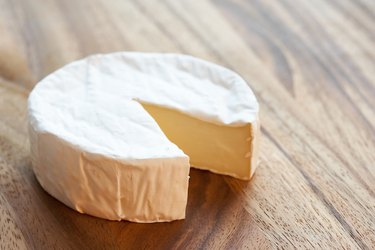
Brie and gruyere are both high-quality cheeses with bold flavors. The cheeses differ in appearance and general use, but both make functional cheeseboard offerings as well as while cooking. Brie originated in France and is made with cow, goat or sheep milk. The cheese gained popularity due to its production proximity to Paris. Gruyere was originally made in Switzerland and requires the milk of black and white Fribourg cows. Gruyere is a specific type of cheese, but it can also refer to a larger class of cheeses, such as Beaufort, Emmentaler and Gruyere de Comte.
Flavor Profile
Video of the Day
Gruyere has a higher quality taste than a standard Swiss cheese. The flavor profile tends to have a nutty notes typical of cheeses made in the Swiss cities. The consistency is buttery and melts well, making it ideal for fondue. At its most mature stage, brie's typical flavor profile includes rich mushroom characteristics. The consistency is creamy, but not runny. The savory taste of brie pairs well with meats such as prosciutto and smoked salmon.
Video of the Day
Rind
Gruyere rind is kept constantly moist to prevent cracking. When ready, the rind turns reddish-brown and is tough, indicating that the flavor will have further developed the nutty flavor associated with gruyere. The rind on brie cheese shows you when it is mature and ready to eat. The rind begins to show pigmentation, or a slight change of color. This means the inside should be soft and creamy. You can eat the rind on brie cheese. It is not recommended to eat gruyere's rind due to its maturing in the open air, making it subject to dirt and dust from the atmosphere.
Aging
Gruyere cheese is often aged until five months and then sold. The cheese is easier to cut at this stage. The flavor will be mild compared to a cheese aged a full year, which is more typical of a higher quality cheese. Brie is typically aged for at least four weeks. If left to mature longer, the flavor becomes stronger and the rind darker and crumbly.
Storing
Store gruyere and brie cheese similarly. Wrap the cheese in wax or parchment paper and cover the entire wheel or wedge in plastic wrap. Gruyere cheese keeps for three to four weeks in the refrigerator, while brie will only keep for one week. Wrap both types of cheese in heavy duty aluminum foil and store in the freezer for up to three months.